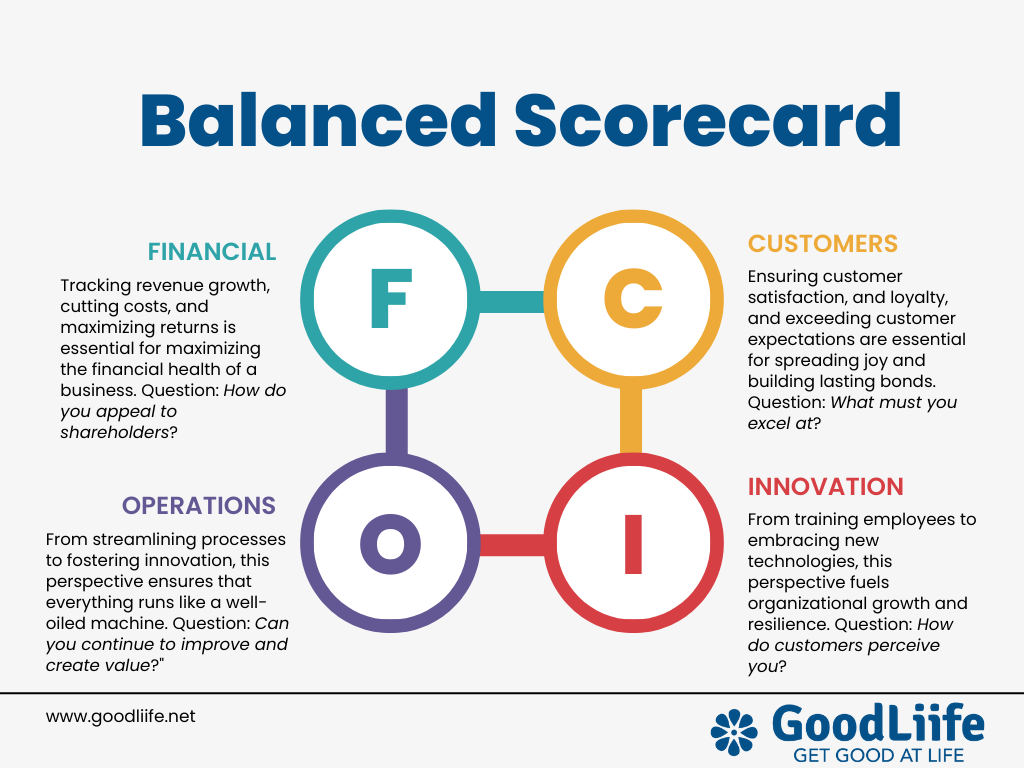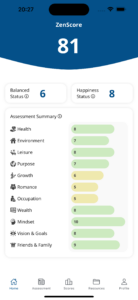GoodLife’s balanced scorecard template is designed to help you create a successful brand. Nowadays, achieving prosperity in business extends beyond mere financial metrics. Sustainable success requires a holistic approach, encompassing financial, operational, customer-centric, and growth dimensions.
In today’s cutthroat business arena, traditional financial metrics alone won’t suffice when it comes to propelling your business to new heights. What you need is a more holistic approach that takes into account all aspects of your organization’s performance.
Enter the Balanced Scorecard (BSC) technique. According to a survey by 2CG, a leading strategic execution consultancy, a whopping 71% of organizations find the BSC extremely useful, with a staggering 75% acknowledging its significant impact on business decisions.
But how do you harness the power of the BSC for your own business? That’s where GoodLiife comes in. This article breaks down the implementation process, guiding you through defining and delivering on goals that span financial, customer, operational, and learning and growth domains.
With GoodLiife’s balanced scorecard template, alongside the comprehensive 6-step guide by your side, you’ll be well-equipped to steer your business towards enduring success.
Why wait any longer? Dive into action with GoodLiife’s balanced scorecard template and this exclusive 6-step guide to conquer your business goals today!
What Is a Balanced Scorecard (BSC)?
- Financial prowess.
- Customer satisfaction.
- Internal operations.
- Learning and growth.
Forged by the dynamic partnership of Robert S. Kaplan and David P. Norton in the ’90s, this tool functions akin to a guiding compass, steering businesses towards enduring success.
Since its inception over two decades ago, the Balanced Scorecard (BSC) has captivated the attention of both scholars and practitioners alike.
The Benefits of the Balanced Scorecard
Benefit #1: Improved Business Optimization
The Balanced Scorecard prevents narrow thinking. Kaplan and Norton, passionate supporters of the BSC, champion its ability to elevate organizational performance. They emphasize that the BSC’s comprehensive perspective pushes managers to go beyond financial metrics, recognizing that enhanced financials don’t always translate to increased profits.
With this perspective, the BSC acts as a safeguard against tunnel vision, ensuring that advancements in one aspect of the business don’t inadvertently undermine others. It compels senior managers to meticulously assess all critical operational measures, fostering a holistic approach to decision-making.
Benefit #2: Streamlined Goal-Setting Procedures
The BSC approach has revolutionized goal-setting by simplifying the process. Businesses rarely suffer from a lack of goals and measures. Rather, managers continuously add more based on valuable suggestions from employees or consultants. The BSC compels managers to concentrate on a select few measures deemed most crucial.
Benefit #3: The BSC Underscores Stakeholder-Oriented Thinking
The BSC acknowledges that businesses rely not only on shareholders but also on a diverse array of stakeholders, such as employees and unions. This balanced perspective cultivates a forward-looking outlook and shareholder-oriented thinking that’s linked to improved business performance.
For instance, according to a report published in the Journal of Applied Corporate Finance, companies fueled by a clear corporate purpose often soar past their competitors when it comes to financial performance and valuation metrics.
Moreover, a shareholder-focused approach has the potential to draw in investors. For example, Ernst & Young reports that 90% of investors closely monitor a company’s performance across various stakeholders, not just shareholders.
But that’s not all. The benefits of the BSC approach also includes:
- Improved employee satisfaction.
- A competitive advantage.
- Reduced costs.
- Facilitation of strategic goal setting and the delivery of time reports.
- Improved connection between teams and stakeholders, both inside and outside of the business.
The Balanced Scorecard: A Breakdown

Let’s break down the balanced scorecard to really grasp it!
There are four key categories of the balanced scorecard. These are:
Financial Perspective: This category focuses on tracking revenue growth, reducing costs, and maximizing returns to enhance the financial well-being of a business. Question: How do you appear to shareholders?
Customer Perspective: This is the core of a business. This category ensures customer satisfaction, and loyalty are surpassed, and your business fosters enduring connections. Question: What must we excel at?
Internal Processes Perspective: Here, you delve behind the scenes to scrutinize every component that keeps your organization running smoothly. From streamlining processes to nurturing innovation, this perspective ensures that everything functions seamlessly. Question: Can you consistently improve and add value?
Learning and Growth Perspective: Consider this category as nurturing a garden, tending to the seeds of learning, innovation, and development. From training employees to embracing new technologies, this perspective drives organizational growth and resilience. Question: How do customers perceive you?
By integrating these four perspectives, the Balanced Scorecard approach ensures that a business thoroughly evaluates success. It ensures that no single category, such as financial health, is prioritized at the expense of others.
Balanced Scorecard Example


Get started on customizing your balanced scorecard by using the template below. Fill it in with your specific business goals, measures, targets, and initiatives for each of the four categories.
Balanced Scorecard Template

How to Use the Balanced Scorecard (In 6 Steps)
Step #1: Start With Your Business Strategy
What’s your current organizational strategy? Ensure your business strategy is a well-crafted, battle-tested blueprint that seamlessly syncs with your vision and mission.
Step #2: Prioritize Your Goals Across the Four Measures of Business Success
Use the template above to define your business goals across the four areas that define success. Set your relevant goals, measures, targets, and initiatives. To help you with this step, the text below gives examples to help.
- Financial: Navigate through traditional financial metrics like sales, revenue, and cost management. These metrics should chart your course toward strategic nirvana, offering shareholders the insights they need for their investment decisions.
- Customer: Kaplan and Norton urge organizations to decipher their target markets before setting objectives related to the customer. Whether it’s about retaining, servicing, or acquiring customers, set your sights on metrics like customer retention, service quality, and profitability per customer.
- Operational: Peer into the inner workings of your business processes, seeking ways to optimize and streamline. From production to sales, set your sights on goals that revolve around quality, efficiency, and cost reduction.
- Learning and Growth: Fuel your organization’s journey with investments in human capital. Empower your people through development, retention, and training initiatives, laying the groundwork for a culture of innovation and continuous improvement.
Step #3: Broadcast Your Scorecard Initiatives
Your entire organization must know your scorecard initiatives. This includes top board members, employees, interns, freelancers, you name it. Everyone who is associated with your business must know what your key business goals are. The below tips will help you do this, ensuring every soul in your organization marches in unison toward a shared vision.
- Top-Down Communication: Start by disseminating scorecard initiatives and key business goals to top-level board members, executives, and managers. These individuals play a pivotal role in setting the strategic direction of the business and must be fully informed about its performance and objectives.
- Departmental Tailoring: Recognize that each department has its unique responsibilities, challenges, and contributions to the overall strategy laid out. For example, for each scorecard initiative, the goals relevant to the marketing department will differ from those of the finance department.
- Cascade Goals: Once department-specific initiatives are established, cascade these down to individual team members. This ensures that everyone understands their role in contributing to the organization’s success and has clear objectives to work towards. Ensure that all employees, regardless of their position or tenure, are included in the dissemination of scorecard results and business goals. This includes interns, freelancers, and contractors.
- Foster Alignment and Collaboration: By ensuring that everyone in the organization is aware of the scorecard initiatives, you promote a sense of unity and collaboration. When every member of the team understands the broader strategic vision and their contribution to it, they’ll work better together.
- Encourage Feedback and Dialogue: Create opportunities for dialogue and feedback regarding the scorecard results and business goals. Encourage employees to ask questions, share insights, and provide suggestions for improvement. This open communication fosters a culture of continuous learning and improvement
Step #4: Define Your Measurement Metrics and KPIs
Firstly, it’s essential to identify the key performance indicators (KPIs) and metrics that align with your strategic goals. These KPIs serve as the guiding stars, illuminating the path towards success. Whether it’s financial metrics like revenue growth or operational metrics like customer satisfaction, each KPI must be carefully chosen to provide actionable insights into performance.
Once the KPIs are identified, the next step is to design a framework for data collection and analysis. This involves determining what data needs to be collected, how it will be collected, and who will be responsible for collecting it. Delegating data collection duties wisely is crucial here, ensuring that the right people are equipped with the necessary tools and resources to gather accurate and timely data.
Next, establish clear benchmarks or targets for each KPI. These benchmarks serve as the yardstick against which progress will be measured. They provide a tangible goal for your organization to strive towards and enable you to track performance over time.
Plus, the performance measurement system should be dynamic and adaptable, capable of evolving alongside your organization. As business conditions change and strategic priorities shift, so too should your performance measurement framework. Regular reviews and updates are essential to ensure that the system remains relevant and effective in driving organizational success.
Step #5: Initiative a Plan of Action
Beak each scorecard initiative into actionable steps or tasks that need to be executed. These steps should be specific, measurable, achievable, relevant, and time-bound (SMART), providing clear guidance on what needs to be done.
Clearly define the roles and responsibilities for each initiative and task. Assign ownership to team members who have the skills, expertise, and resources to execute effectively. Ensure that everyone understands their role and accountability in the implementation process. Plus, ensure that team members have access to the resources, tools, and support they need to execute the initiatives successfully. This may include financial resources, technology, training, or additional manpower. Address any barriers or challenges that may hinder progress.
Step #6: Evaluate and Evolve
Keep a vigilant eye on your measurement processes; if something seems off, adjust course accordingly. Utilize feedback sessions to glean insights into your team’s progress and needs, transcending mere financial targets to embrace a holistic view of performance and potential.
The Balanced Scorecard and Beyond
The essence of the GoodLiife application is balance. In this sense, the GoodLiife brand aligns seamlessly with the ethos surrounding the balanced scorecard approach. By highlighting the BSC, this article aims to support you in your career goals, which is just one aspect of what it means to have a balanced life.
But there’s more. Did you know you can actually apply the concept of the BSC to your personal life too? This forms what is called the personal balanced scorecard. The personal balanced scorecard offers a straightforward method to refocus your attention on what truly counts. Borrowing from business principles, this approach empowers you to cultivate life habits and allocate your time wisely to nurture a sense of balance and harmony in your life.
To find out more, head to Personal Balanced Scorecard: How to Use the Business Balanced Scorecard Approach for Improved Well-Being.

Utilize the GoodLiife Scorecard as your trusty companion to create a balanced life. The GoodLiife Scorecard will ask you how you feel about different areas of your life. Think of it as your monthly check-in to track your progress. Here you can celebrate your wins, and pinpoint life areas for improvement.


Leave a Reply